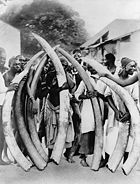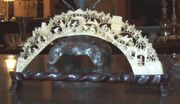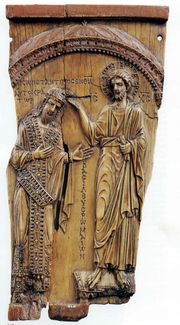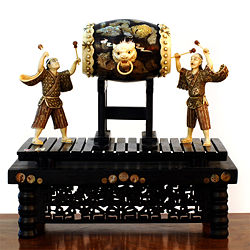Ivory
2008/9 Schools Wikipedia Selection. Related subjects: Materials science
Ivory is formed from dentine and constitutes the bulk of the teeth and tusks of animals such as the elephant, hippopotamus, walrus, mammoth and narwhal.
The word "ivory" was traditionally applied to the tusks of elephants; the word is ultimately from Ancient Egyptian âb, âbu "elephant".
Ivory has availed itself to many ornamental and practical uses. Prior to the introduction of plastics, it was used for billiard balls, piano keys, bagpipes, buttons and a wide range of ornamental items. Synthetic substitutes for ivory have been developed. Plastics have been viewed by piano purists as an inferior ivory substitute on piano keys, although other recently developed materials more closely resemble the feel of real ivory.
Structure
The chemical structure of the teeth and tusks of mammals is the same regardless of the species of origin. The trade in certain teeth and tusks other than elephant is well established and widespread, therefore "ivory" can correctly be used to describe any mammalian teeth or tusks of commercial interest which is large enough to be carved or scrimshawed.
Teeth and tusks
Teeth and tusks have the same origins. Teeth are specialized structures adapted for food chewing. Tusks, which are extremely large teeth projecting beyond the lips, may give certain species an evolutionary advantage.
Tusks are modified teeth, both of which share the same physical structures: pulp cavity, dentine, cementum and enamel. The innermost area is the pulp cavity. The pulp cavity is an empty space within the tooth that conforms to the shape of the pulp.
Ivory in art
Paleolithic Cro-Magnon man, during the late stages of the ice age, were the first to carve in ivory (mammoth tusks). Both the Greek and Roman civilizations used large quantities of ivory to make high value works of art, precious religious objects, and decorative boxes for costly objects. Ivory was often used to form the white of the eyes of statues.
The Syrian and North African elephant populations were reduced to extinction, probably due to the demand for ivory in the Classical world.
The Chinese have long valued ivory for both art and utilitarian objects. Early reference to the Chinese export of ivory is recorded after the Chinese explorer Zhang Qian ventured to the west to form alliances to enable for the eventual free movement of Chinese goods to the west; as early as the first century BC, ivory was moved along the Northern Silk Road for consumption by western nations. Southeast Asian kingdoms included tusks of the Indian elephant in their annual tribute caravans to China. Chinese craftsmen carved ivory to make everything from images of Buddhist and Taoist deities to opium pipes.
The Indianized Buddhist cultures of Southeast Asia, including Myanmar (Burma), Thailand, Laos and Cambodia traditionally harvested ivory from their domesticated elephants. Ivory was prized for containers due to its ability to keep an airtight seal. Ivory was also commonly carved into elaborate seals utilized by officials to "sign" documents and decrees by stamping them with their unique official seal.
In Southeast Asian countries where Muslim Malay peoples live, such as Malaysia, Indonesia and the Philippines, ivory was the material of choice for making the handles of magical kris daggers. In the Philippines, ivory was also used to craft the faces and hands of Catholic icons and images of saints.
Tooth and tusk ivory can be carved into a vast variety of shapes and objects. A small example of modern carved ivory objects are small statuary, netsukes, jewelry, flatware handles, furniture inlays, and piano keys. Additionally, warthog tusks, and teeth from sperm whales, orcas and hippos can also be scrimshawed or superficially carved, thus retaining their morphologically recognizable shapes.
Consumption before plastics
Before plastics were invented, ivory was important for cutlery handles, musical instruments, billiard balls, and many other items. It is estimated that consumption in Great Britain alone in 1831 amounted to the deaths of nearly 4,000 elephants. Ivory can be taken from dead animals — Russians dug up tusks from extinct mammoths — however most ivory came from elephants who were killed for their tusks. Other animals which are now endangered were also preyed upon, for example, hippos, which have very hard white ivory prized for making artificial teeth.
Availability

Due to the rapid decline in the populations of the animals that produce it, the importation and sale of ivory in many countries is banned or severely restricted. Much of the decline in population is due to poachers during and before the 1980s. Since the worldwide ivory trade ban in 1989 there have been ups and downs in elephant populations, and ivory trade as bans have been placed and lifted. Many African countries including Zimbabwe, Namibia and Botswana claim that ivory trade is necessary—both to stimulate their economies and reduce elephant populations which are allegedly harming the environment. A 1999 study done by Oxford University found that less than one percent of the five-hundred million US dollars ivory sales generated ever reach Africans; most of it goes to middlemen and vendors. However, in 2002 the United Nations partially lifted the ban on ivory trade, allowing a few countries to export certain amounts of ivory. The effectiveness of the policy is in question, in light of the study preceding the ban, and an updated study would be needed to evaluate the current state of the ivory trade.
In 2007 eBay, under pressure from the International Fund for Animal Welfare, made the decision to ban all international sales of elephant ivory products. The IFAW found that up to 90% of the elephant ivory transactions on Ebay violated their own wildlife policies and could potentially be illegal. The ban does not affect trade within the United States but only trade between sellers in different countries.
Kenya, which saw its elephant populations plummet in the decade preceding the 1989 ban, claims that legalizing ivory trade anywhere in Africa will endanger elephants everywhere in Africa as poachers would attempt to launder their illegal ivory with legal stockpiles.
The 2006 Zakouma elephant slaughter in Chad is one of a long series of massacres which have eliminated some ninety-six percent of the original 300,000 African elephant population of Chad in only four decades.
Trade in the ivory from the tusks of dead mammoths has occurred for 300 years and continues to be legal. Mammoth ivory is used today to make handcrafted knives and similar implements.
The demand for ivory is primarily from the Japanese hanko industry. Hankos are small seals used for signing documents. Traditionally, these hankos were also made from other material. Ivory hankos were introduced only in the last century.
A species of hard nut is gaining popularity as a replacement for ivory, although its size limits its usability. It is sometimes called vegetable ivory, or tagua, and is the seed endosperm of the ivory nut palm commonly found in coastal rainforests of Ecuador , Peru and Colombia.
On July 15, 2008, the United Nations panel overseeing the CITES convention granted China and Japan permission to import elephant ivory from African government stockpiles in a one-time auction. The auction will comprise approximately 44 tons from Botswana, 9 tons from Namibia, 51 tons from South Africa, and 4 tons from Zimbabwe. The Chinese government in 2003 acknowledged that it had lost track of 121 tons of ivory between 1991 and 2002.
Types of ivory
- Elephant and mammoth ivory from the tusks of bull elephants and mammoths
- Walrus ivory from the tusks of a bull walrus
- Warthog ivory
- Hornbill ivory, derived from a bird, is not true ivory but resembles it





